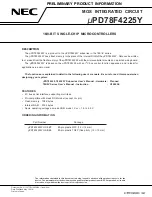
CHAPTER 9: THEORY OF OPERATION
SERIES COMPENSATED LINES
D30 LINE DISTANCE PROTECTION SYSTEM – INSTRUCTION MANUAL
9-19
9
Distance protection elements of the D30 deal with the problem of current inversion by using a multi-input-comparator
approach as described in the Distance Characteristics section. If the current inversion happens, the distance elements are
secure on reverse faults because multiple conditions involving fault-loop, negative-sequence and zero-sequence currents,
and the memory voltage are checked prior to declaring a forward fault.
On close-in forward faults beyond the series capacitors as seen from the relaying point, the current inversion phenomenon
can take place for a short period of time. The condition cannot sustain for a long time as very high fault currents would
occur, causing large voltage drops across the series capacitors and prompting the overvoltage protection of the
capacitors to operate quickly. This effectively removes the series compensation and eliminates the current inversion.
However, when the currents used by distance comparator (fault-loop current for ground and phase distance protection,
and the negative- and zero-sequence currents for ground elements) stay shifted by more than 90 degrees from their
natural fault position determined by the user as the element characteristic angle, the distance elements can fail to pick up
on such a forward fault for the brief period of current inversion. This is an inherent attribute of the 100% memory polarized
mho element, and not a weakness particular to the D30 relay.
Therefore, for dependability, it is recommended to use high-set phase overcurrent protection for direct tripping on close-in
faults potentially causing current inversion, and overreaching ground fault directional overcurrent functions (such as
negative-sequence, ground, or neutral) for communication-aided schemes.
The problem of steady-state overreaching due to the negative reactance of the series capacitors can be addressed in the
D30 in a traditional way by shortening the reach of an underreaching distance elements to the net inductive reactance of
the line between the potential source and the far end busbar(s). This generic approach has two major drawbacks. First, it
leaves large portion of the line uncovered by the directly tripping distance protection. Second, it does not solve the
transient overreaching problem caused by sub-synchronous oscillations.
Therefore, the D30 offers a unique option for dynamic reach control that is effectively based on the magnitude of the
current flowing through the series capacitor bank(s). The underreaching distance functions can be set as for plain
uncompensated line, that is, using the impedance of the line alone, and the relay then controls an effective reach
accordingly using the current magnitude as illustrated in the following figure.
The reach is reduced sufficiently to cope with both steady-state and transient overreach phenomena. For large degrees of
compensation and small-current faults, the transient overreach can be as high as 100%. This means that fast distance
protection is not achievable. The adaptive D30's mechanism guarantees security on external faults. Use overreaching
ground fault directional overcurrent functions (such as negative-sequence, ground, or neutral) for dependability.
Figure 9-7: Dynamic reach control
Section (a) of the following figure shows the effect of adaptive reach control for low-current external fault. The reach is
reduced sufficiently to cope with both transient and steady-state overreach. Section (b) shows a high-current external
fault. The air gaps or MOVs conduct the majority of the fault current and neither steady-state nor transient overreach
Содержание D30 series
Страница 10: ...x D30 LINE DISTANCE PROTECTION SYSTEM INSTRUCTION MANUAL TABLE OF CONTENTS ...
Страница 14: ...1 4 D30 LINE DISTANCE PROTECTION SYSTEM INSTRUCTION MANUAL FOR FURTHER ASSISTANCE CHAPTER 1 INTRODUCTION 1 ...
Страница 52: ...2 38 D30 LINE DISTANCE PROTECTION SYSTEM INSTRUCTION MANUAL SPECIFICATIONS CHAPTER 2 PRODUCT DESCRIPTION 2 ...
Страница 534: ...5 324 D30 LINE DISTANCE PROTECTION SYSTEM INSTRUCTION MANUAL TESTING CHAPTER 5 SETTINGS 5 ...
Страница 564: ...6 30 D30 LINE DISTANCE PROTECTION SYSTEM INSTRUCTION MANUAL PRODUCT INFORMATION CHAPTER 6 ACTUAL VALUES 6 ...
Страница 578: ...7 14 D30 LINE DISTANCE PROTECTION SYSTEM INSTRUCTION MANUAL TARGETS MENU CHAPTER 7 COMMANDS AND TARGETS 7 ...
Страница 614: ...9 26 D30 LINE DISTANCE PROTECTION SYSTEM INSTRUCTION MANUAL FAULT LOCATOR CHAPTER 9 THEORY OF OPERATION 9 ...
Страница 654: ...A 10 D30 LINE DISTANCE PROTECTION SYSTEM INSTRUCTION MANUAL FLEXANALOG ITEMS APPENDIX A FLEXANALOG OPERANDS A ...
Страница 662: ...C 6 D30 LINE DISTANCE PROTECTION SYSTEM INSTRUCTION MANUAL COMMAND LINE INTERFACE APPENDIX C COMMAND LINE INTERFACE C ...
Страница 670: ...iv D30 LINE DISTANCE PROTECTION SYSTEM INSTRUCTION MANUAL ABBREVIATIONS ...
Страница 686: ...xvi D30 LINE DISTANCE PROTECTION SYSTEM INSTRUCTION MANUAL INDEX ...
















































